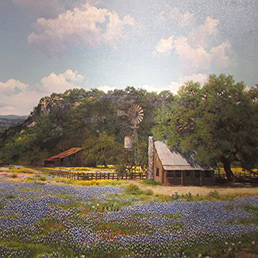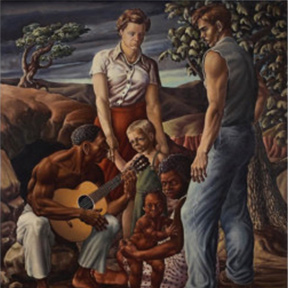- (214) 720-4044
- info@daviddike.com
- Mon - Fri: 10 am - 5 pm
Ward, Velox
Velox Ward
(Am. 1901-1994)
WARD, VELOX (1901–1994) is an artist who debunks the notion that memory painters always filter reality in order to idealize it: Ward intended to paint the nostalgia of by-gone days as he remembered them, but his stark, atmospheric pictures of life in East Texas in the early twentieth century diverge from idealized memories and tend more toward realism. Ward painted many outdoor scenes of people in their daily lives—butchering meat, ginning cotton, baling hay, sounding a dinner horn, napping on a porch. In his serene, spare landscapes he accentuated geometric perspective, depicting views into and through windows, doors, and breezeways. Even an interior view of a working sawmill opens out to show the deep space of a distant landscape.
Ward was born near Hopewell in Franklin County, East Texas. According to Margaret Vogel, it amused him to have been named after a German sewing machine that had a label reading “Speed and Accuracy.” Ward left school to help support the family after the death of his father (a farmer who had failed in several business ventures) and thereafter worked at more than the usual variety of jobs because of restlessness as well as for Ward began to paint in 1960, when his three children asked him to paint a picture for each of them as a Christmas present. The experience was enjoyable for Ward, and he painted additional pictures that he hung in his shoe repair shop. People began to buy them, and eventually he was able to devote himself to painting full time. Donald and Margaret Vogel, who owned the Valley House Gallery in Texas, were impressed by his work and began to represent him.
Ward’s ideas for his approximately 200 paintings in oil on canvas or Masonite (which are usually 20 by 24 inches) came from memory, imagination, and photographs. Each work took from three weeks to three months to complete. For each composition, he would make paper cutouts of the major forms (he called these “cutout dolls”), then trace them onto the canvas or panel before beginning to paint. In works such as Mama Blows the Horn (1967), Everybody Doesn’t Work (1964), Girl with Hoop (1964), and The Unfinished House (1968), Ward experiments with slightly irregular perspectival techniques, creating detailed linear compositions that seem to compress and expand space. A sense of realism is achieved through the smooth surfaces and diminished brush work, despite Ward’s lack of technical training. The result is a carefully worked out composition that emphasizes abstract shapes and forms.
In 1972, Ward had a one-person exhibition at the Amon Carter Museum in Fort Worth, Texas that trav-eled to the Wichita Falls Museum in Texas, the Dallas Museum of Fine Arts, and elsewhere.
BIBLIOGRAPHY Adele, Lynne. Spirited Journeys: Self Taught Artists of the Twentieth Century. Austin, Tex. , 1997. Rosenak, Chuck, and Jan Rosenak. Museum of American Folk Art Encyclopedia of Twentieth Century American Folk Art and Artists. New York, 1990. Steinfeldt, Cecilia. Texas Folk Art: One Hundred Fifty Years of the Southwestern Tradition. Austin, Tex., 1981. Vogel, Donald, and Margaret Vogel. Velox Ward. Fort Worth, Tex., 1972. LEE KOGAN





